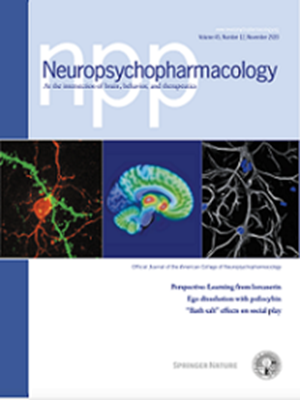Associations between structural brain measures and cognitive function in bipolar disorder: a systematic review and meta-analysis
IF 6.6
1区 医学
Q1 NEUROSCIENCES
引用次数: 0
Abstract
Bipolar disorder (BD) is a chronic condition characterized by recurrent mood episodes and persistent cognitive deficits that span multiple domains, ultimately impacting daily functioning. Understanding the neural underpinnings of these impairments is crucial. In a systematic review and meta-analysis examining 80 studies (with 50 meeting criteria for meta-analysis) of adults with BD, relationships between structural brain measures and cognitive performance were evaluated. Participants were diagnosed according to standard criteria, underwent structural and diffusion-weighted MRI, and completed standardized cognitive assessments. The meta-analyses indicated significant associations between both grey matter and white matter indices and cognitive functioning, reflected in moderate effect sizes. Notably, these associations exhibited substantial heterogeneity. Meta-regression revealed that bipolar subtype and current mood state moderated the observed brain-cognition relationships, with bipolar I and euthymic individuals showing higher associations with grey matter metrics. Cognitive domain differences also played a key role, indicating that certain cognitive functions are more strongly linked to structural brain measures than others. Brain networks emerged as a global influence on cognition, with limited differences in pairwise comparisons. Age, sex, psychosis, and mania were not found to significantly moderate these relationships. Overall, this work suggests that structural alterations in grey and white matter in individuals with BD may contribute meaningfully to cognitive difficulties, while brain networks may provide a broad integrative framework for these associations. These findings underscore the importance of considering both global and specific neural factors when exploring the pathophysiology of cognitive impairment in BD.

双相情感障碍患者脑结构测量与认知功能之间的关系:一项系统综述和荟萃分析。
双相情感障碍(BD)是一种慢性疾病,其特征是反复发作的情绪发作和跨越多个领域的持续认知缺陷,最终影响日常功能。了解这些损伤的神经基础是至关重要的。在一项系统综述和荟萃分析中,对80项成人双相障碍研究(其中50项符合荟萃分析标准)进行了研究,评估了大脑结构测量与认知表现之间的关系。参与者根据标准标准进行诊断,接受结构和弥散加权MRI检查,并完成标准化的认知评估。荟萃分析表明,灰质和白质指数与认知功能之间存在显著关联,反映在中等效应大小上。值得注意的是,这些关联表现出实质性的异质性。元回归显示,双相亚型和当前情绪状态调节了观察到的脑-认知关系,双相I型和心境障碍个体与灰质指标的关联更高。认知领域的差异也发挥了关键作用,表明某些认知功能与大脑结构测量的联系比其他功能更紧密。大脑网络对认知产生了全球性的影响,在两两比较中差异有限。年龄、性别、精神病和躁狂症对这些关系没有明显的调节作用。总的来说,这项工作表明双相障碍患者灰质和白质的结构改变可能对认知困难有意义,而大脑网络可能为这些关联提供了一个广泛的综合框架。这些发现强调了在探索双相障碍认知功能障碍的病理生理学时考虑全局和特定神经因素的重要性。
本文章由计算机程序翻译,如有差异,请以英文原文为准。
求助全文
约1分钟内获得全文
求助全文
来源期刊

Neuropsychopharmacology
医学-精神病学
CiteScore
15.00
自引率
2.60%
发文量
240
审稿时长
2 months
期刊介绍:
Neuropsychopharmacology is a reputable international scientific journal that serves as the official publication of the American College of Neuropsychopharmacology (ACNP). The journal's primary focus is on research that enhances our knowledge of the brain and behavior, with a particular emphasis on the molecular, cellular, physiological, and psychological aspects of substances that affect the central nervous system (CNS). It also aims to identify new molecular targets for the development of future drugs.
The journal prioritizes original research reports, but it also welcomes mini-reviews and perspectives, which are often solicited by the editorial office. These types of articles provide valuable insights and syntheses of current research trends and future directions in the field of neuroscience and pharmacology.
 求助内容:
求助内容: 应助结果提醒方式:
应助结果提醒方式:


